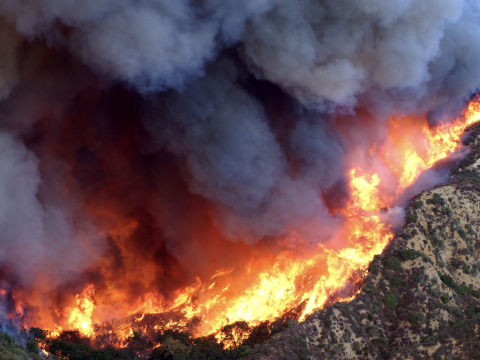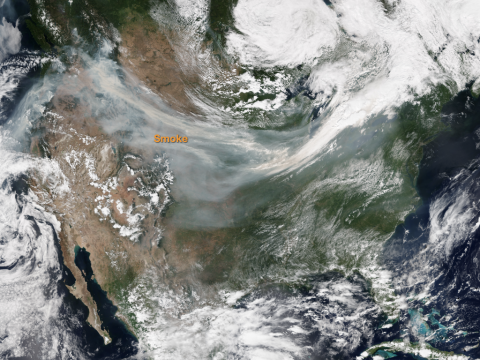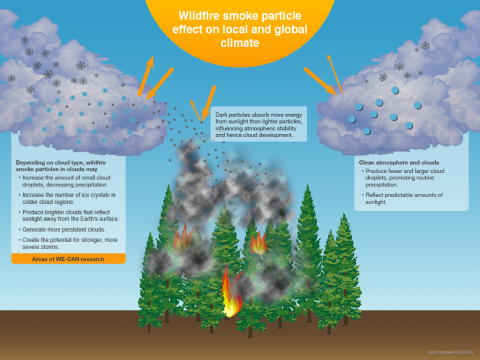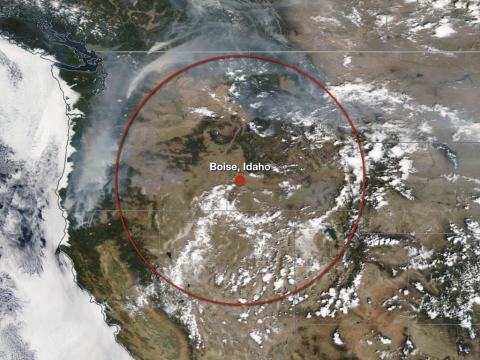Tell us about WE-CAN and what it is that you're studying?
The Western Wildfire Experiment for Cloud Chemistry, Aerosol Absorption and Nitrogen (WE-CAN) study aims to better understand the chemistry of wildfire smoke, and is based in Boise, Idaho from 22 July - 31 August 2018. The project is funded by the U.S. National Science Foundation (NSF) and supported by the National Center for Atmospheric Research (NCAR). The project is led by Principal Investigators from Colorado State University, the University of Washington, the University of Colorado at Boulder, the University of Montana, and the University of Wyoming. U.S. Federal Agency collaborators include NOAA and NASA.
Understanding the chemistry in western wildfire smoke has major ramifications for air quality, nutrient cycles, weather, and climate. The main objectives of WE-CAN are to systematically identify and quantify the emissions from western wildfires and to understand how smoke plumes evolve over the first 24-hours after emission.
The team is focused on three sets of scientific questions related to wildfire smoke plumes: 1) reactive nitrogen, 2) particles, and 3) cloud development and chemistry.
| Science Objective | Motivation |
|---|---|
| To increase understanding of the amount and types of reactive nitrogen within smoke plumes. | Reactive nitrogen includes all forms of nitrogen that are biologically, photochemically, and radiatively active within the environment. Reactive nitrogen in wildfire smoke plumes influences air quality as well as how nitrogen is deposited back into the ecosystem. |
| To quantify and understand emissions and evolution of fine particulate matter mass and optical properties in wildfire smoke. | There is no consensus regarding how the amount, composition, and interactions of smoke particles with sunlight change with fire conditions and during transport downwind of a fire. Fine particles from wildfires have significant impact on human health and climate. |
| To identify how wildfire smoke plume particles of different ages affect the behavior and formation of liquid and ice clouds. | Particles from wildfires affect cloud formation and development. Smoke can be scavenged and chemically processed by cloud droplets, thus changing the composition of the smoke particles. |
What is unique about studying wildfire smoke plumes versus other types of smoke plumes (i.e., factories, smog, etc.)?
Power plants, major roadways and cities don’t move! Wildfires can range in size and severity. How long they will last and where they will inject smoke into the atmosphere depend on many factors and are therefore difficult to predict. These factors make sampling wildfire smoke, even with a platform as nimble as the NSF/NCAR C-130 challenging. Despite the challenges associated with doing so, studying wildfire smoke is important.
Wildfire occurrences in the western U.S. have increased over last three decades, with higher frequency, longer duration, and extended seasons. Climate driven changes in aridity is likely to favor more fires in the western U.S. It is predicted to continue increasing over next half century as a result of warmer climate. While pollution emissions from traditional sources (i.e. vehicles, power production) are expected to decline due to successful regulations, the importance of wildfire smoke as a major source of air pollutants could continue to grow.
A wildfire charges up a mountain slope, producing thick, black smoke filled with chemicals and aerosols.
Wiki Commons
What are the societal benefits of a project such as this?
Exposure to wildfire smoke has been associated with a suite of adverse health effects, and WE-CAN will document the emissions and evolution of air pollutants in smoke plumes. The WE-CAN observations will also improve our ability to predict storms and rainfall in smoke-filled environments. Finally, smoke particles impact local and global climate and WE-CAN observations will help us better understand the extent of warming and cooling caused by smoke particles. Smoke from wildfires is a global issue, therefore understanding its behavior and impact has great benefit across the globe.
Tell us more about the importance of studying reactive nitrogen in wildfire smoke plumes?
The change in characteristics over time and formation of new reactive nitrogen compounds determine the chemical reactions that occur within the plume, as well as those that occur downwind. These changes are key to understanding the amount and eventual form of nitrogen that is returned back to the ecosystem.
Nitrogen emitted from fires in a form that is chemically combined with oxygen (i.e. NOx [NO and NO2]) can contribute to ozone (O3) formation as the plume ages. Better quantifying biomass burning emissions of NOx from fires will become increasingly important for prediction of ozone as human-produced U.S. NOx emissions decrease with increased emission regulations.
NOx is the dominant reactive nitrogen species emitted during flaming combustion and ammonia (NH3) is the dominant reactive nitrogen species emitted during smoldering. There is evidence of considerable amounts of emissions of NH3 from biomass burning. Though there is no consensus regarding how biomass burning NOx emission estimates from North American fuels, we know substantially more about the emissions of NOx than for ammonia or other nitrogen containing species. It is important to understand all forms of reactive nitrogen in smoke because they have different implications for air quality and nitrogen deposition.
NASA Earth Observatory
Why is it important to understand the optical properties of particle in smoke plumes?
lack carbon particles (i.e., soot) are the largest atmospheric absorber of visible light and are thought to be the largest human-caused activity driving warming of the Earth’s climate after carbon dioxide (CO2) and possibly methane (CH4). The largest source of black carbon globally is thought to be wildfires, but wildfires also emit other organic particles with different chemical composition that scatter and absorb light differently than black carbon. The relative importance of absorption versus scattering from these particles remains uncertain. This is important for scientists to resolve because this is a major source of uncertainty in climate models.
How can smoke from wildfires affect cloud formation?
The immense numbers of particles lofted from wildfires will be ingested by developing clouds and storms as the smoke is carried by winds. Depending on atmospheric conditions and the physical and chemical properties of smoke particles, more dense clouds of smaller droplets may form, which are more reflective and persist longer, cooling the regional atmosphere. The smaller droplets may decrease the efficiency of precipitation from shallow clouds and invigorate convection in deeper/colder clouds. At the same time, fires can be large sources of particles on which ice can form, effectively “seeding” the clouds with more ice crystals, potentially resulting in increased precipitation.
Smoke from wildfires affects cloud formation.
Alison Rockwell, NCAR/EOL
Why did you select Boise, Idaho as the base of operations?
Boise, Idaho is the ideal operations base due to its central location to western wildfires. Based on the past occurrence of major wildfires during July and August, we expect sufficient fire activity within a 1-2 hour flight of Boise, ID to sample a variety of fires over the course of a 6-week intensive field mission.
The Boise Airport offers the necessary resources to support the operations of the NSF/NCAR C-130, the main research platform for the project. A runway long enough to support the take-off and landing of a fully loaded C-130 is a top requirement, as well as access to fuel.
The red circle shows about a 2-hour flight range from Boise, Idaho.
NCAR/EOL
How are data being collected?
WE-CAN is using the NSF/NCAR C-130 research aircraft, essentially a flying laboratory, to conduct 16-18 research flights within about a 350 mile radius of Boise, Idaho during the six-week project.
The NSF/NCAR C-130 is owned by the National Science Foundation and managed and operated by specialized staff in the Earth Observing Laboratory.
The C-130 originally served as a cargo plane, so it is able to carry a large payload of instruments while also having a range of more than 1500 miles and the ability to fly between 1000 – 15,000 feet in altitude. These aspects are important in order to fully characterize the atmospheric chemistry of smoke plumes, because smoke can be injected into the atmosphere at many altitudes, and pollutants in smoke can be transported by the wind over large distances.
As part of WE-CAN, the C-130 is carrying a suite of state-of-the-art instruments designed to measure a range of trace gases, fine particles, cloud microphysics, and standard meteorological parameters such as temperature, radiation, and winds.
WE-CAN Data Submission Instructions (Post Field)
Dataset Documentation ("Readme") Guidelines
Quick Questions for WE-CAN PIs



